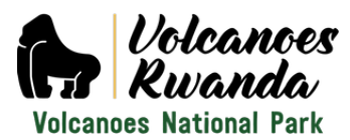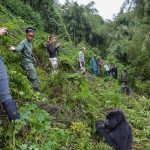How tough are the gorilla groups in Volcanoes National Park? Which group is the hardest group? What about the easiest gorilla family and how long does it take to track the mountain gorillas? These are some of the frequently asked questions by intending gorilla trekkers when planning for gorilla trekking safaris to the Volcanoes National Park, yet very difficult to answer because it is not easy to predict the movement of the gorilla family. A group that you expect to be easy to track can turn out to be difficult because mountain gorillas are wild animals that are not stationed in one place but rather keep moving for a number of reasons.
Volcanoes National Park is situated in North-western Uganda and is a haven to 10 habituated gorilla families that include Sabinyo, Susa A, Bwenge, Agashya/group 13, Susa B (Karisimbi), Kwitonda, Umubano, Ugenda, Hirwa and Amahoro groups. It is always a common practice to intending gorilla trekkers to understand the experience of tracking each of the 10 habituated gorilla groups. However, it should not ignored that several parameters involved in the gorilla trekking experience which make it difficult to answer the question of which group is the hardest or easiest to track, the fact that the parameters that determine the experience keep changing. Today you will hear trekkers saying the gorilla group was very easy to track, yet the next day tourists will track the same group but come back cursing the entire experience.
Gorilla trekking is conducted in two separate phases. The first phase involves hiking from the nearest car Park to the forest/National Park boundary, which normally lasts between half an hour and one hour depending on the pace of the trekkers in the group and the trailhead of the group you intend to visit. The second phase involves trekking through the jungles to search for the mountain gorillas group which you have been probably located by the advance trackers by the time you arrive the forest/Park border.
The first phase of the activity is quite predictable and is not strenuous because the area is fairly flat and unchallenging unless you are visiting the Susa A family which involves longer and steeper climbing. The second phase on the other hand is more demanding and hard to predict since it largely depends on the location of the mountain gorilla group on the day you are tracking and also on the steepness of the landscape enroute to the home range of the group. Other aspects in ascertaining how tough the hike will be and also depends on the thickness of the vegetation (crawling and bending through the jungles can be challenging especially if you wish to avoid the fierce stinging nettles). Also if it rained recently, the trails will become muddy and slippery and also influences the level of difficulty. Age is undeniably an important factor that influences the level of difficulty because the old tourists will find hiking more difficult than the young energetic tourists.
Tourists of 30s and below find it less challenging to track most of the gorilla families in Volcanoes National Park, apart from the Susa A which is considered the most difficult group to track. The Trekkers above 50 years always find it very strenuous to go by the normal pace hence require regular breaks between the trails to rejuvenate.
However, the most important factor that affects the level of difficulty is the location of the home range of the gorilla family you are tracking. Susa A family inhabits the steep slopes of the Karisimbi Volcanoes posing a challenging climb for trekkers on a gorilla trekking safari in the Volcan0es National Park. Sabinyo family is considered the easiest and most reliable family that has a straight forward route to reach. Hiking to Umubano and Amahoro families are also challenging but not to the level of Susa A. The other groups-Kwitonda, Agashya and Hirwa groups are somewhat less challenging.
Nevertheless, even when all this is said, remember that mountain gorillas are wild animals that are not stationed in one place but keep moving and unfortunately, their movements cannot be predicted. Therefore where you meet them each day changes depending on their movement, which is sometimes determined by the scarcity/abundance of food. You might expect the Susa A to be very challenging and the Sabinyo to be less challenging, yet it turns out to be vice versa.
In conclusion, Susa A is considered the less challenging gorilla family while the Sabinyo group is the most challenging of all the habituated gorilla families. However, this is greatly unpredictable due to the changing movement of the mountain gorillas.


